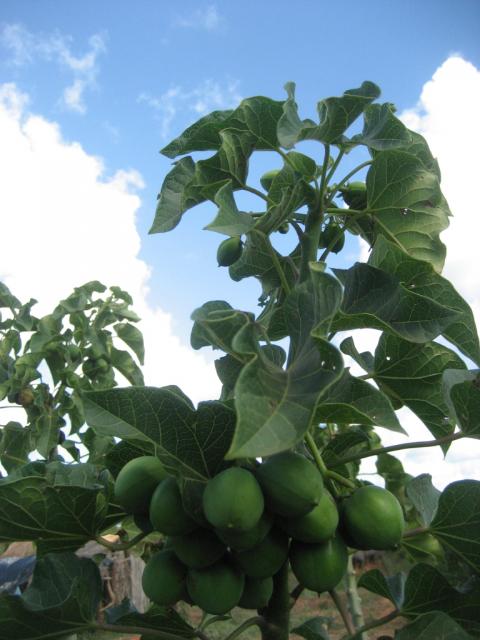
Agro Diesel (India) Private Ltd
Overview
-
Lavori pubblicati 0
-
Visualizzati 11
Descrizione azienda
Pests Of Jatropha
Jatropha Curcas is acquiring importance commercially as the demand of nonrenewable fuel sources increases tremendously and likewise Jatropha is an eco-friendly energy plantation. Plantation of this plant is considered to be an excellent fuel alternative and it is likewise extremely affordable compared to other fuels. Recently, Jatropha is facing some problem with bugs and illness. The insects are categorized into 2 ranges: Pest that affect young plants and Pest that impact developed plants.
Young plant pests: Cutworm, Scarabeid Beetle, Army worm, Grasshopper.

Agrotis ipsilon: It is commonly called Cut worm. This insect impacts the seedlings and young Jatropha plants. If the plant is impacted by the cutworm, the stem gets cut nearer to the soil surface and this will diminished the plant totally.
Control: This pest can be managed by selecting the larva discovered around the plants or by mixing the bran, sawdust with insecticides.
Scarabaeid Beetle: This pest damages the root of the young plant. Initially, the larva consumes the natural matters present in the soil and after that pertains to the root. The larva attack might eliminate the entire plant.
Control: The plant with good resistance power can get rid of the insect. For heavy attack, insecticides with elements carbosulfan and carbofuran can be utilized to kill the bug.
Army worm: Spodoptera litura existence can be identified by biting in the leaves. The extreme infection could totally kill the plants.
Control: Insecticides are utilized to manage the bugs.
Grasshopper: This is common pest discovered in several plants. Valanga nigricornis and Locusta migratoria widely assaults the plant. The insect typically attacks the young plant.
Control: The insecticides utilized betacyfluthrin, cypermethrin, thiodicarb, MIPC, and fipronil.
Pest observed in fully grown plants:
Pest of Stem: Ostrinia furnacalis, Xyleborus spp.
Ostrinia furnacalis and Xyleborus: This pest damages the Jatropha stem and it is commonly seen in Indonesia. The stem attacked by this bug generally drop. The presence can be determined by the larva penetration hole at the stem.
Control: The Insecticide normally used to control this pest is carbofuran.
Pest of leaf: The common insects observed are leaf caterpillar, Neetle caterpillar, Leaf hopper, Mite, Ear corn caterpillar.
Leaf Caterpillar: This pest can consume all the leaves of the plant simply put duration. The quality and yield of the seeds get minimized due to the heavy attack.
Control: This can be managed by picking the old larvae around the surface area and tossing away the assaulted leaves.
Needle Caterpillar: This caterpillar is covered with spines and produces a burning sensation when enabled to exposure to skin as it produces certain chemical substance. Initially the bug crowded in the leaf and then spread all over the plant when it ages.
Control: Manually, the insect can be eliminated just by it in water or kerosene. The heavy attack can be controlled by spraying organophosphate insecticides.
Leaf Hopper: This insect is found mostly in tropical and subtropical regions. The pest targets the leaf and draws all the nutrients of the leaf and gets curls at the idea. Later, the entire leaf dry and pass away.
Control: The heavy attack can be managed by using insecticides like imidachloprid, beta cyfluthrin or carbosulfan.
Mite: Mite also attacks the leaf and makes the entire plant weak. The pest presence can be recognized when the leaf ended up being yellow-colored, shrinks, reddens and drop. The pest can also be spread out through fallen leaves.

Control: Some preventive measures can be done like appropriate sanitation and burning the fallen leaves. Heavy attack can be dealt with by spraying insecticides.
Some terrible insect which assaults flower and fruit are, Stink bug (Nezara viridula)
Chrysocoris javanus, Tip borer caterpillar.
Stink Bug: Sting bug is a serious insect which attacks the plant during bloom period so the crop yield completely drops. This bug is seen around the tropical region.
The hazardous enzyme in the plant diminishes the entire plant.

Control: Insecticides advised for this bug is chlorfluazuron, diflubenzuron, alfamethrin, and lamda cyhalothrin.
Tip borer caterpillar: The insects frequently takes place attacks the plant in blooming season and this bug is seen widely in tropical areas. The female bug laid the eggs on the tender part of the plant and the young larvae feed the young fruits and plant pointers.
Control: Manually, the assaulted seeds are suggested to burn. The insecticides like monocrotophos and bensultap are sprayed at the blooming season.
